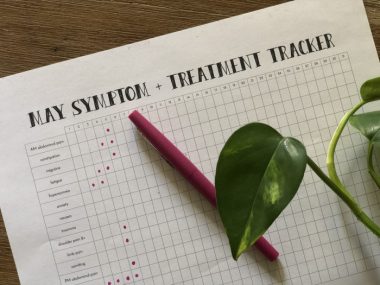The Symptom-tracking Method That Actually Works for Me

Deep in the dark recesses of my bottom filing cabinet drawer is a collection of hard-bound, brightly colored planners from years past. Each agenda represents a year in my life — 365 days of to-do lists, Little League games, project deadlines, doctors’ appointments, birthdays, book clubs, coffee dates, meetings, and vacations.
These tomes take me back in time to years when my disease was unfamiliar, I prioritized work over health, and was learning to trust my body. Leafing through page by page, I can find a series of secret codes written in the margins, charting numbers on a pain scale, hours of sleep, and doses of medication. It took me four years to develop an effective method to track daily porphyria symptoms.
***
I live with an active case of acute hepatic porphyria, and I like to know what to expect. That’s why I started recording porphyria triggers and accompanying symptoms from the moment I was diagnosed.
It started as an attempt to take my power back. I carted a yearly planner with me everywhere, scribbling down notes anytime my abdomen hurt or I lost a night of sleep. I looked for noticeable patterns, but found it challenging to chart such a wide variety of symptoms, each with their own level of severity. I wanted a way to objectively measure my disease burden that I could share with my health providers and use to hold myself accountable for self-care.
2017
My 2017 planner was adorned in black-and-white stripes and embellished with gold foil accents. It chronicled a year of desperate instability: receiving my diagnosis, getting fired from my job, attending an unending series of specialists’ appointments across the country, and facing a looming countdown to losing my health insurance. I didn’t yet understand my disease triggers enough to track their impact on my health, and I was in a flare most of the time.
2018
My 2018 planner looked like an illustrated cottage garden. In it, I attempted to manage the responsibilities of a full-time job, correspondence with a national porphyria expert, and regular care from a local hematologist. I felt more in control of my health than I had in recent years. My symptoms became easier to track, as I was receiving consistent porphyria care for the first time in my life.
2019
In 2019, my planner featured Southwestern geometric patterns in navy blue, mustard yellow, and green. After reevaluating my job situation, I focused on making peace with my body. Instead of project deadlines and meetings, the pages of my planner were filled with notes on symptoms, pain ratings, and treatment. Using the monthly spreads, I experimented with ways to track my porphyria, trying to uncover patterns and help me predict flares.
2020
My 2020 planner is jewel-toned with hand-drawn elements, and it still looks brand new. Like most things in 2020, my symptom-tracking methods went out the window around March. With everything going on in the world at that point, I was tired of unsuccessfully monitoring my porphyria symptoms. Instead, I focused on one tried and true trigger: hormones. Using a menstrual cycle tracking app, I was able to plan for the rough weeks preceding my period.
2021
My 2021 planner is a bullet journal. I was experiencing a porphyria attack from March 25 to April 7 (when I was finally hospitalized). The only reason I know that is because of the little purple dots I keep on some gridded paper.
As usual, I am late to the #BuJo trend. But I’m telling you, a pre-filled grid featuring all my symptoms day by day is a game changer because it meets two basic requirements: It’s easy to track, and it’s easy to comprehend.

I have a bullet journal spread to track my health month to month. Every time I experience a porphyria symptom, I can simply mark a dot under the day. (Photo by Claire Richmond)
All of my previous planners were full of indecipherable notes in the margins of each day, afterthoughts surrounding meeting times or social events. A note on “p.m. pain” could be referring to abdominal, limb, or shoulder, depending on the context. Quite simply, it was a mess.
Before this year, I filled planners with information about my disease, but they functioned more like diaries. Using a bullet journal approach, I’ve developed an easy way to create data points, track my most troublesome symptoms, and monitor treatments.
For This Porphyria Life, an online community I co-founded with my friend Candace, we created a printable symptom and treatment tracker for others to use. Download your own here.
***
Note: Porphyria News is strictly a news and information website about the disease. It does not provide medical advice, diagnosis, or treatment. This content is not intended to be a substitute for professional medical advice, diagnosis, or treatment. Always seek the advice of your physician or other qualified health provider with any questions you may have regarding a medical condition. Never disregard professional medical advice or delay in seeking it because of something you have read on this website. The opinions expressed in this column are not those of Porphyria News or its parent company, Bionews, and are intended to spark discussion about issues pertaining to porphyria.







Leave a comment
Fill in the required fields to post. Your email address will not be published.